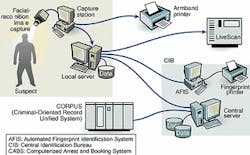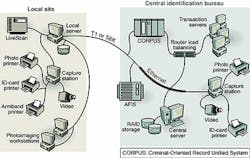Imaging system recognizes suspects
In response to law-enforcement needs, imaging system provides digitized mug shots that are compared to databases for precise identification.
By R. Winn Hardin, Contributing Editor
In the late 1990s, the Sheriff's Department of Alameda County in Northern California, which includes San Francisco, Oakland, and Santa Clara, evaluated its more than 20,000 annual adult arrests and realized that faster operating and more accurate suspect identification tools were needed. The existing slow techniques used film-based mug shots, ink fingerprints, and hardcopy police records that were stored, accessed, and reviewed by manual means. Moreover, the storage of paper records was occupying an increasing number of cabinets and real estate.
In response to the county's request for proposal, Orion Scientific Systems (Sacramento, CA) eventually won a contract for a criminal imaging system. This system provides digitized mug shots and has facial-recognition capabilities to quickly search previous arrest records, server-based distributed Sequel databases capable of interfacing with a legacy IBM mainframe computer at Alameda County's Central Identification Bureau (CIB), network attached storage (NAS), and an interconnected wide-area network.
FIGURE 1. In the Multiagency Uniform Imaging System (MUGS), a suspect's picture is taken at the booking station. Imagis ID 2000 software performs a facial-recognition search through all the pictures on both the local and central Sequel servers to see if it is already in the system. If it is not, a new personal file number (PFN) is issued. The data are sent from the Computerized Arrest and Booking System (CABS) to LiveScan, which adds fingerprint data to the Sequel file and sends the entire file across the LAN to an external Internet connection. Then, the file is sent by frame relay to the Central Identification Bureau (CIB), where the data are verified by the Automated Fingerprint Identification System (AFIS). Upon receipt by the central server, the data are uploaded to the Criminal Oriented Record Unified System.
MUGSThe Multiagency Uniform Imaging System (MUGS) connects 13 local-area networks (LANs) at various criminal booking agencies in and around Alameda County (see Fig. 1). The Alameda County Sheriff's Department prebooking facility represents a standard node on the MUGS network, according to Eric Zidenberg, vice president and project manager for MUGS at Orion Scientific Systems."Each booking agency has its own Dell Computer (Round Rock, TX) Optiplex 110 Capture Station and 2400 PowerEdge server running Microsoft Corp. (Redmond, WA) Windows 2000 and Sequel Server 2000 software. After the suspect's picture is taken, Imagis (Vancouver, BC, Canada) ID 2000 software performs a facial-recognition search through all the pictures on both the local and central Sequel servers. The imaging system then takes the preliminary identification, passes it along to Identix (Los Gatos, CA) fingerprint stations, and the county CIB confirms the identity through a fingerprint match," Zidenberg explains.
The imaging process begins with an analog video stream captured by either a Hitachi (Simi Valley, CA) VKC-77U tripod-mounted camera or a Pelco (Orangeburg, NY) SD5TAC Spectra Lite Dome ceiling-mounted video camera, depending on the exact setup at each prebooking facility. The video camera is connected via coaxial cable to a Hauppauge Computer Works (Hauppauge, NY) WinTV PCI frame grabber in a capture station. This station comes standard with a 833-MHz Pentium III processor, 256 Mbytes of RAM, a 17-in. Sony (Park Ridge, NJ) P7880 Trinitron monitor, and an Intel Corp. (Santa Clara, CA) 10/100 Base-T Ethernet chipset running on Windows 2000.
Other peripherals connected to the capture station include a Hewlett-Packard (Palo Alto, CA) 2250 TN ink-jet printer, which is capable of photo-quality printing and handling full-sized reports with embedded pictures at high speeds; an ALPS Electric (San Jose, CA) MD-5000 constant-tone printer for publishing photographic armbands for each suspect; and a Fargo (Eden Prairie, MN) Persona C25 ID printer for smart cards and identification badges, which are used mainly for officers and law-enforcement staff.
Mining imagesTo begin the imaging process, the booking officer clicks the 'freeze' icon on the capture-station computer, which runs the Imagis' Computerized Arrest and Booking System (CABS) application (see Fig. 2). This application uses a Microsoft Sequel database with a Visual Basic front end customized for law-enforcement applications. It also works with Oracle Sequel, according to Imagis' chief technology officer Andy Amanovich.Embedded in the database's front end is the ID2000 facial-recognition software module. This software uses ActiveX controls capable of fitting into the front ends of most software programs, including those written in C++ and Visual Basic, Amanovich says.
"The ID2000 software gets dumped into a particular list of code according to COM-object-oriented programming rules. While the underlying mathematical procedures for the facial-recognition algorithm are proprietary, they were originally developed for airborne digital imagery, such as satellite imagery, and we brought that technology into the world of forensics. The technology does not analyze features of a face, but rather, elements of reflected light. It generates 3-D surfaces, such as a face, based on reflection and absorption of light. That's a much different approach than that used by conventional feature analysis," Amanovich adds.
He further explains that the ID2000 software searches for brightness valleys and peaks and creates a 3-D surface map based on those areas, even when the image is only a profile. The software can then Z-rotate the 3-D surface map to aid officers in comparing live video, such as surveillance cameras, pictures, and even sketches from police artists, against stored frontal and profile mug shots. Says Orion's Zidenberg, "If an officer takes a picture of someone with a digital camera, the officer can cut and paste that photo into the Imagis software and do a facial-recognition search, as well."
The CABS takes the captured still image from the video camera and displays it on the prebooking screen. If the officer does not like the picture, the officer can simply hit 'freeze' again and take another picture. From there, the officer pushes "transmit" and the ID2000 software converts the JPEG image into a mathematical transform using Imagis' facial-recognition algorithm. This transform is sent across the local 10/100 Ethernet/LAN to the CABS Sequel database on the local Dell PowerEdge 2400 server. Here, biographic data, mug shots, and other image-based evidence are stored on an 18-Gbyte internal hard drive.
According to Zidenberg, an analysis of the network suggested that 18 Gbytes were adequate for 11 of the 13 booking agencies. However, the remaining two booking agencies perform 80% of the bookings for the system and use 36 Gbytes of hard-drive space on their local PowerEdge servers. A central server that backs up the biographical and image data from all 13 locations uses a 72-Gbyte Dell PowerVault NAS system in addition to 36 Gbytes of internal hard-drive storage.
In addition to sending the mug-shot transforms to the local 2400 server, the capture station also sends the data to the central CABS Sequel server at the CIB, which duplicates the data of every arrest performed at all 13 booking facilities. "We don't mind duplication, because memory is cheap," says Orion's Zidenberg. A series of close matches is returned to the officer at the capture station, where the officer can pick a matching photo. Based on a match, the CABS pulls up the suspect's personal file number (PFN) from the local or central Sequel database, assuming the suspect has a PFN from a previous arrest. The new images, updated biographical data, and officer's remarks are added to the file. Next, the entire file is sent across the LAN to an Identix LiveScan digital fingerprint imager.
LiveScan adds the fingerprint data to the Sequel file and sends the entire file across the LAN to an external Internet connection. Then, the file is sent by frame relay to the CIB (see Fig 3). If the suspect has a previous record, CIB officers can verify the PFN by comparing the Identix digital fingerprints to the suspect's fingerprints stored in a law-enforcement standard database—Automated Fingerprint Identification System (AFIS). If the search is not successful using the Sequel database, then the CIB does a comprehensive search on the AFIS using the new Identix digital fingerprints. This search either confirms that the suspect does not have an existing file and issues a new PFN or provides the missing PFN number.
The confirmed PFN, commensurate biographical data, and arrest record, or new PFN, are then returned to the capture station, where the booking officer saves the confirmed updated file. The CABS stores the file to the local and central Sequel servers and sends the information to one of four transaction servers that interface with the county's mainframe computer. The four PowerEdge servers interface through a custom Visual Basic program built by Orion across a TCP/IP connection to an IBM 3270 emulator package resident on the county's UNIX-based mainframe. The mainframe, which runs the Criminal Oriented Record Production Unified System (CORPUS) application, is the final repository for all criminal information.
Extending the networkZidenberg says that the mainframe's bandwidth is adequate to handle all foreseeable data-handling needs. Therefore, bottlenecks are more likely to occur when interfacing with the mainframe rather than inside it. Orion installed four 2400 servers to guard against bottlenecks that might occur when uploading information to CORPUS or downloading background information for criminal investigations.Under normal conditions, two transactional servers interface with CORPUS, a third server is used for training, and a fourth server tests code changes to the mainframe interface. In the event that the mainframe connection goes down, new arrest information is stored in a separate Microsoft Access database for later uploading to CORPUS, with communications between the Access and Sequel databases provided by macro routines.
The last of the 13 LANs are scheduled to be on-line by early 2002, according to Zidenberg. This would bring the final number of participating agencies to 30, although only 13 are booking facilities. The remaining agencies include district attorney's offices and other locations where suspects are neither booked nor held.
FIGURE 3. Alameda County Sheriff's Department imaging system includes 13 local sites connected to the Central Identification Bureau (CIB). The Computerized Arrest and Booking System application fits into the latest desktop computers and turns every PC that is connected to the LAN into a potential photoimaging workstation. External transmission between local sites and CIB is through local frame-relay services at typically T1 or fractional T1 transmission rates. One site uses a minimum 56-kbit connection; however, this slow connection is workable because JPEG mug shots that conform to the California law-enforcement picture standard are approximately 30 kbytes. Four transaction servers balance the incoming facial-recognition search requests among the 13 local servers and the central server to reduce search times.
The next step will be to push the MUGS out to police officers on the street through their in-car computer systems. Then officers will be able to take pictures of suspects, upload digital pictures, and perform searches based strictly on images.
Imagis is getting ready to launch the newest version of ID2000 software—a general scene-analysis program that will be used by the UK National Crime Squad to analyze entire pictures, not just faces, and draw connections between separate crimes based on common visual elements.
Company InformationALPS Electric (USA) Inc.San Jose, CA 95134www.alpusa.comDell Computer Corp.Round Rock, TX 78682www.dell.comFargo Electronics Inc.Eden Prairie, MN 55344www.fargo.comHauppauge Computer WorksHauppauge, NY 11788www.hauppauge.comHewlett-Packard Co.Palo Alto, CA 94304www.hp.comHitachi Koki Imaging Solutions Inc.Simi Valley, CA 93063Web: www.hitachi-hkis.comIdentix Inc.Los Gatos, CA 95032www.identix.comImagis Technologies Inc.Vancouver, BC, Canada V6E 3C9www.imagistechnologies.comIntel Corp.Santa Clara, CA 95052www.intel.comMicrosoft Corp.Redmond, WA 98052www.microsoft.comOrion Scientific SystemsSacramento, CA 95826www.orionsci.comPelcoOrangeburg, NY 10962www.pelco.comSony ElectronicsPark Ridge, NJ 07656www.sony.com


